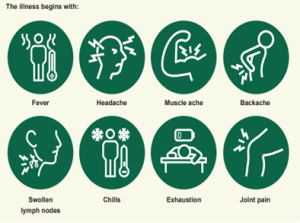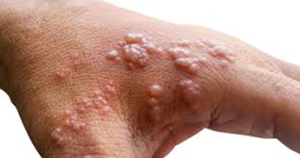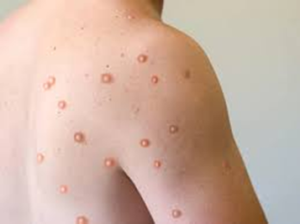Please click the frequently asked questions below for further information and IPC precautions required:
-
What is Mpox?
Mpox (previously known as monkeypox) is a rare disease caused by infection with the mpox virus. Mpox virus is part of the same family of viruses as variola virus, the virus that causes smallpox. Mpox symptoms are similar to smallpox symptoms, but milder, and mpox is rarely fatal. Mpox is not related to chickenpox.
Mpox was first discovered in 1958 when outbreaks of pox like disease occurred in monkeys kept for research. The first human case was recorded in 1970 on the Democratic Republic of Congo (DRC). Since then it has been occurred in several African countries, before 2022 most cases were reported in DRC and Nigeria.
There are 2 main genetic groups of Mpox known as clades. In 2022 cases of human Mpox were reported in multiple counties including the UK and Ireland. This is was associated with sexual activity and was caused by Mpox Clade II. Clade II is no longer considered a High Consequence Infectious Disease (HCID) in the UK.
Clade II MPXV is responsible for the global outbreak that began in 2022.
Clade I MPXV is currently considered more severe than Clade II MPXV, leading to its classification as a high consequence infectious disease (HCID).

-
Clade 1
Case Definitions
Patients who meet the following criteria should be managed as a case of Clade I Mpox
- confirmed mpox case where Clade I is confirmed through laboratory testing
- confirmed or clinically suspected Mpox, clade not yet known and
- there is a travel history to the DRC or specified countries where there may be a risk of Clade I exposure or
- a link to a suspected case from those countries within 21 days of symptom onset or
- there is an epidemiological link to a case of Clade I Mpox within 21 days of symptom onset
The list of affected countries can change rapidly, to check the current information visit: Clade I mpox: affected countries – GOV.UK (www.gov.uk)
-
How does it spread?
Mpox can spread to anyone through close, personal, often skin-to-skin contact, including:
- Direct contact with mpox rash and scabs from a person with mpox, as well as contact with their saliva, upper respiratory secretions, and areas around the anus, rectum, or vagina
This direct contact can happen during intimate contact, including:
- Oral, anal, or vaginal sex, or touching the genitals (penis, testicles, labia, and vagina) or anus of a person with mpox
- Hugging, massage, and kissing
- Prolonged face-to-face contact
- The risk is considered low for getting mpox by touching objects, fabrics, and surfaces that have been used by someone with mpox and not disinfected, such as clothing, bedding, towels, fetish gear, or sex toys.
Other points to remember:
- Incubation period is between 5 and 21 days
- It is usually a self-limiting illness, where people recover within several weeks. However, some can develop severe illness.
- People are considered infectious from onset of symptoms until scabs have fallen off and there is intact skin underneath.
-
What are the symptoms of Mpox?
 People with mpox often get a rash that may be located on hands, feet, chest, face, or mouth or near the genitals, including penis, testicles, labia, and vagina, and anus.
People with mpox often get a rash that may be located on hands, feet, chest, face, or mouth or near the genitals, including penis, testicles, labia, and vagina, and anus.- The rash will go through several stages, including scabs, before healing.
- The rash can initially look like pimples or blisters and may be painful or itchy.
Other symptoms of mpox can include:
- Fever
- Chills
- Swollen lymph nodes
- Exhaustion
- Muscle aches and backache
- Headache


-
Why is this important?
If NIAS staff are aware that the patient has a suspected or confirmed Mpox this should be communicated to EAC / NEAC and the receiving unit when transferring the patient to ensure effective patient care and management.
This should also be communicated to the IPC team in hours or when next available.
-
IPC Precautions
All cases of suspected Mpox should be treated as a potential case of Mpox Clade 1 due to the difficulty of distinguishing between Clade 1 and Clade 2 in the community setting.
All suspected cases of Mpox:
- This should be treated as a HCID using Mpox Airborne Precautions
- A fit tested FFP3 mask – Ensure a fit check is completed
- A Fluid resistant Coverall
- Full face visor
- Gloves
- Apron
Confirmed Clade 2:
- Fit-tested FFP3 respirator
- Eye protection
- Long sleeved, fluid repellent, disposable gown or Coverall
- Gloves
Conveyance:
When the patient is on a vehicle ensure that –
- the ventilation systems are operational
- the bulkhead is closed
- on arrival at a receiving unit ensure that you inform the staff you have arrived before entering so that the patient can safely be moved to the appropriate room for HCID
- if the patient can tolerate it ask them to wear a fluid resistant surgical mask
- Non-essential persons (relatives) should not travel with the patient. However, if due to exceptional circumstances the patient is accompanied, they should be asked to also wear a fluid resistant surgical mask if able.
-
What cleaning is required?
- All equipment and the ambulance should have a deep clean with a hypochlorite solution with a strength of 10,000 PPM (Same dilution as blood and body fluids).
- Appropriate Mpox Airborne PPE should be worn when decontaminating the vehicle and the equipment.
- Any single use equipment should be disposed of.
- Open all doors to allow the vehicle to be ventilated before and during cleaning.
- Waste can be treated as healthcare (clinical) category B waste. It can be disposed of in an orange bag for alternative treatment and does not have to be sent for incineration. The waste is assigned to UN 3291, clinical waste.
- Linen must be bagged in an alginate bag and sealed, then placed into a red linen bag and secured prior to placement with the soiled linen. If the patient is transported to hospital follow the receiving units guidance for this linen. If the patient is not being transported any linen used by NIAS staff can be disposed of as clinical waste.
-
Do staff need prophylaxis or follow up?
A list of staff will be recorded of all staff who have had interaction with the suspected/confirmed case.
All staff in contact with a case of Mpox will be individually risk assessed by the multi-agency team.
If you believe you have had a breach in PPE, ensure line manager and OH are informed immediately.
- Links to guidance




